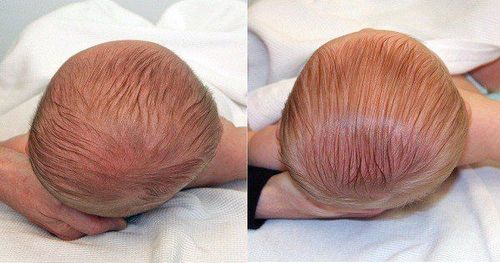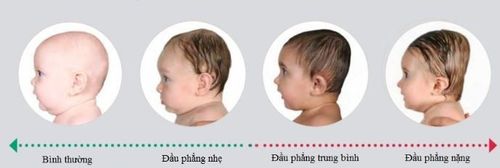This is an automatically translated article.
Flat head syndrome is a common condition in infants, characterized by an asymmetrical baby's head, the back or the side of the baby's head is flat or deformed.
1. Flat head syndrome in babies
Plagiocephaly is a condition in which a child's head is asymmetrical or deformed. The reason for this phenomenon is that the skull of a newborn is quite soft, can change shape when applied force. Factors that increase the risk of infant flat head syndrome are:
Baby sleeping on their back: infants spend most of the day sleeping. Lying on your back is the most common sleeping position, which reduces the risk of sudden infant death syndrome (SIDS). However, when a baby sleeps on their back continuously, pressure is applied to a stretch point that creates a flat surface on the skull. Premature babies: Premature babies have a higher risk of flat head syndrome because the skulls of premature babies are softer than those born at full term. Mother gives birth to many children at once: a mother carrying many babies will limit the growth space of the fetus. As a result, some twins or triplets may have flat head syndrome before birth. For mothers with only one pregnancy but a small uterus, the fetus does not have much space to grow and move, the baby is also at high risk of flat head syndrome. Vestibular pregnancy: Flat head syndrome can also occur with breech babies, because the baby's skull is compressed by the mother's ribs. Children with torticollis: Children with torticollis will have the head tilted to one side and the chin tilted to the opposite direction. Babies with torticollis are also at increased risk for flat head syndrome because they often sleep with their heads turned to one side. Another form of flat head syndrome is Craniosynostosis, which is a birth defect in which the skull is deformed because the bones of the skull close prematurely. Infants with craniosynostosis need surgery for normal brain development.

Hình ảnh trẻ mắc hội chứng đầu phẳng ở trẻ sơ sinh
2. How to detect flat head syndrome in babies?
Many vaginal births have heads that are deformed due to the pressure of the birth canal. This will usually resolve on its own in about 6 weeks. However, if after 6 weeks of age, the baby's head is still not round. Or if you find that your baby has a flat spot on the skull for the first time after 6 weeks of age, it is very likely that the baby has flat head syndrome.
Most cases of flat head syndrome improve by the time the baby is 6 months old, when the baby starts to crawl and sit up. However, a small number of severe cases of flat head can cause some health problems such as astigmatism, developmental delay, difficulty speaking, loss of vision, risk of hearing loss,... Therefore, When you notice that your child's head is flat at any time, do not wait, but take your child to see a doctor. Your baby's skull will get harder and harder as he gets older. So methods to help adjust the skull will be more convenient when the child is young.
3. How is flat head syndrome in children treated?
Measures to help correct flat head syndrome in children are carried out according to the principle of frequently changing the position of the infant when lying down to avoid putting pressure on the flattened head area. Some measures you can take include:
Place your baby on his or her side, alternately on the left and right side while the baby sleeps. Most children's beds are placed against the wall, you should put the baby to lie with his or her head towards the foot of the bed or the head of the bed, alternating days. This will encourage the child to lie on his or her head to look into the room. Never use rolled towels or positioning devices to hold the baby's head to the side. This will increase the risk of sudden infant death syndrome (SIDS) and suffocation. Alternate feeding positions to avoid putting pressure on the flat head position. Limit children lying on their backs or resting their heads for long periods of time on flat surfaces such as car seats, baby swings, infant seats, etc. Promote tummy time: while the baby is awake When you wake up, you should strengthen the baby to lie on his stomach to develop motor skills. Lying on your stomach also helps strengthen your neck muscles. As the neck muscles get stronger, babies can move their heads during sleep, which improves flat head syndrome. Regularly hug and hold your baby to help reduce pressure on his head. Physical therapy: The doctor can guide parents to give their child physical therapy exercises every day to help increase the range of motion in the child's neck. These exercises must be performed correctly and regularly for a certain amount of time to be effective.

Hội chứng đầu phẳng ở trẻ sơ sinh được chia làm các mức độ khác nhau
If the above corrections are not successful, the infant flat head syndrome is severe, the doctor will consider craniofacial surgery. The use of helmets for cranial orthopedic surgery is the most commonly used method. Children need to wear helmets about 23 hours a day to correct their head shape. Treatment usually lasts two to six months, depending on the age of the child at the start of treatment and the severity of the flat head syndrome.
Helmet therapy is often combined with physical therapy to achieve the best results. The best age to start treatment is when the baby is about 6 months old. Wearing a helmet may not be as effective after 12 months of age because the skull cannot reshape as the bones have thickened.
When examining children for flat head syndrome, the doctor will check the child for early craniosynostosis, congenital torticollis or cervical spine abnormalities. If the child has the above diseases, the doctor will choose the right treatment method for the child's condition.
Pediatrics department at Vinmec International General Hospital is the address for receiving and examining diseases that infants and young children are susceptible to: viral fever, bacterial fever, otitis media, pneumonia in children, .... With modern equipment, sterile space, minimizing the impact as well as the risk of disease spread. Along with that is the dedication from the doctors with professional experience with pediatric patients, making the examination no longer a concern of the parents.
If you have a need for consultation and examination at Vinmec Hospitals under the nationwide health system, please book an appointment on the website for service.
Please dial HOTLINE for more information or register for an appointment HERE. Download MyVinmec app to make appointments faster and to manage your bookings easily.
Reference source: babycenter.com












